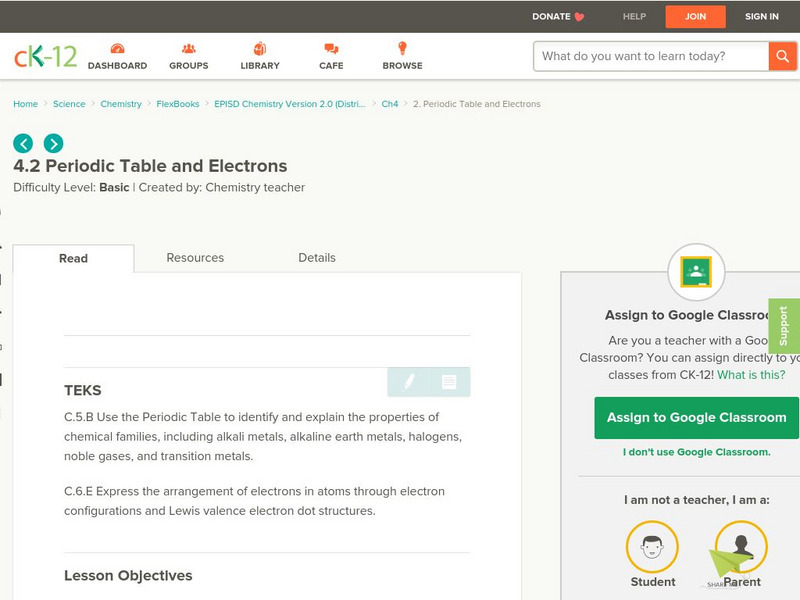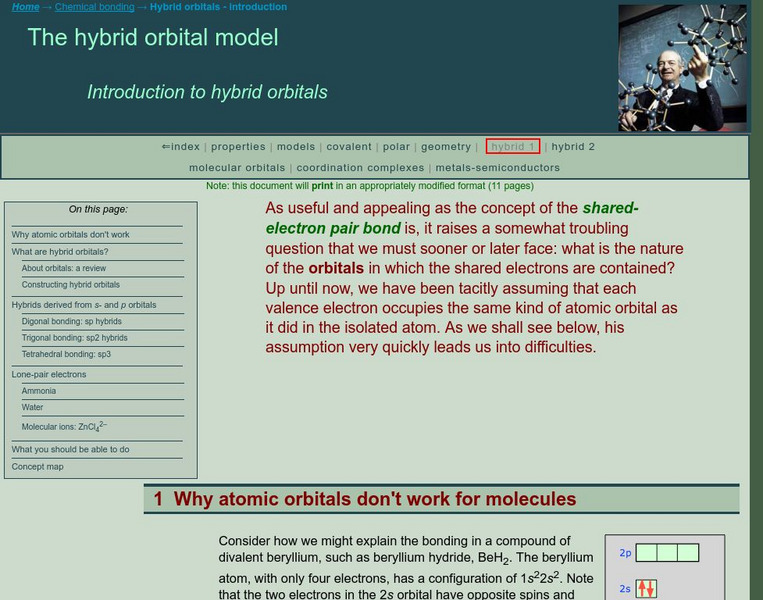NBC
Nbc Learn: Chemistry of Pumpkin Pie
Most recipes for Thanksgiving pumpkin pies call for clove and nutmeg - two distinct spices that come from two nearly identical molecules: eugenol and isoeugenol. "The Chemical Bond Between Cloves and Nutmeg" explains how the strength and...
Chemistry Collective
Chem Collective: Metal Ligand Binding
Use silver chloride to determine the binding constant for a metal ligand complex.
Texas Education Agency
Texas Gateway: Ionic and Covalent Bonding
In this tutorial, students learn about ionic and covalent bonds and predict which elements will form which type of bond. Includes interactive exercises as well as videos.
University of California
Organic Chemistry Page: A Brief Tutorial on Drawing Lewis Dot Structures
An excellent lesson on writing Lewis structures. Examples shown include ammonium ion, carbon dioxide and the carbonate ion.
Concord Consortium
Concord Consortium: Stem Resources: Chemical Bonds
By working through this web-based activity, students differentiate between ionic, non-polar covalent, and polar covalent bonds. Specifically, distinctions are made between bonding types based on orbital shapes and electronegativity...
American Chemical Society
Middle School Chemistry: Chapter 4: The Periodic Table and Bonding
Six middle school chemistry lessons about the periodic table and bonding complete with handouts and animations.
PBS
Pbs Learning Media: Chemical Bonds
This interactive activity developed for Teachers' Domain demonstrates how attractive forces between atoms create chemical bonds, resulting in the formation of molecules and compounds.
CK-12 Foundation
Ck 12: Electron Configuration and the Periodic Table
[Free Registration/Login may be required to access all resource tools.] In the following online tutorial students will sse the Periodic Table to identify and explain the properties of chemical families, including alkali metals, alkaline...
Simon Fraser University
Chem1 Virtual Textbook: Molecules and the Properties of Bonded Atoms
College-level site goes into great detail about chemical bonding properties, as far as energies, structure, angles, and length. Infrared absorption, the greenhouse effect, and global warming are addressed to exemplify bond length...
Utah Education Network
Uen: Classroom Bonding
Students will be assigned an ion "name tag" and move around the classroom finding suitable other "atoms" to bond with.
Concord Consortium
Concord Consortium: Stem Resources: Making and Breaking Bonds
A look at the processes of association and dissociation in chemical bonding. Observe simulations that show the influence of temperature on making and breaking of bonds, how diatomic molecules form, and what determines the speed of...
Texas Instruments
Texas Instruments: Chemical Bonds
This StudyCards stack enables students to review the vocabulary that describes chemical bonding.
University of California
Resonance: Drawing Resonance Structures
An extensive lesson from UCLA on drawing resonance structures. Includes several examples, and links to related topics. Practice problems are also provided.
Simon Fraser University
Chem1 Virtual Textbook: Models of Chemical Bonding: Why Do Chemical Bonds Form?
This extensive overview on chemical bonding seeks initially to answer the question, why do chemical bonds form? Information is provided on classical models of chemical bonding and quantum mechanical models of the chemical bond.
Simon Fraser University
Chem1 Virtual Textbook: Models of Chemical Bonding: Why Do Atoms Join Together?
The General Chemistry Virtual Textbook, or Chem 1, is broken into several sections covering various aspects of topics related to chemistry. This section deals with chemical bonds and seeks to answer the question, why do chemical bonds form?
Simon Fraser University
Chem1 Virtual Textbook: The Octet Rule
The General Chemistry Virtual Textbook, or Chem 1, is broken into several sections covering various aspects of topics related to chemistry. This section deals with the history and uses of the octet rule. Biographical information on G.N....
Simon Fraser University
Chem1 Virtual Textbook: The Valence Bond Model
The General Chemistry Virtual Textbook, or Chem 1, is broken into several sections covering various aspects of topics related to chemistry. This section deals with hybrid orbitals and specifically the valence bond model.
Simon Fraser University
Chem1 Virtual Textbook: Hybrid Types and Multiple Bonds
The General Chemistry Virtual Textbook, or Chem 1, is broken into several sections covering various aspects of topics related to chemistry. Acting as a second part to a discussion on hybrid types of bonding, this site specifically...
Simon Fraser University
Chem1 Virtual Textbook: Molecular Orbitals
Acting as an overview from the General Chemistry Virtual Textbook, this site explores the topics related to molecular orbitals including bonding and antibonding MOs, molecular orbital diagrams, sigma and pi orbitals, and more.
Crescent Public Schools
The Internet Science Room: Oxidation Numbers and Chemical Bonding
Through animated diagrams and illustrated examples, students can further their understanding of chemical bonds and oxidation numbers.
Simon Fraser University
Chem1 Virtual Textbook: Electron Tunneling Model
Find out about shared electrons between the two nuclei. Learn about uncertainty at work.
Michael Blaber, PhD
Fsu: Basic Concepts of Chemical Bonding: Exceptions to the Octet Rule
Lists the exceptions to the octet rule and provides a discussion and diagrams explaining each one. Includes clear diagrams illustrating this concept.
Towson University
Towson University: Drawing Lewis Structures
Brief rules for writing Lewis structures for simple compounds. Some examples are included.
State University of New York
State University of New York: Atomic Electron Configuration
This simulation displays the electron configurations of for the elements in relation to the element's position on the periodic table.






















